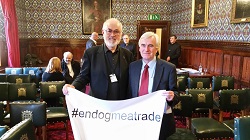John McDonnell MP
John McDonnell hosted a meeting to highlight the cruelty of Dog Meat Trade and call for a ban on this barbaric practice. Participants viewed two films, Sio Dog and Django Story and heard speeches from Tobias Ellwood MP, John Hawkridge and an excellent and moving speech from Peter Egan. Judy Dench, a supporter of the campaign also attended the meeting.
136 MPs signed at Early Day Motion to call for an immediate end to Dog Meat Trade Cruelty http://www.parliament.uk/edm/2014-15/159
 Dog and cat meat is consumed in several regions of the world, including parts of Europe, Russia, Africa and Latin America. However, it is most widespread in Asia, where the welfare concern is greatest due to the high numbers of dogs and cats being taken from the streets, transported long distances and brutally slaughtered. In South Korea, dogs are also intensively farmed for the meat trade.
Dog and cat meat is consumed in several regions of the world, including parts of Europe, Russia, Africa and Latin America. However, it is most widespread in Asia, where the welfare concern is greatest due to the high numbers of dogs and cats being taken from the streets, transported long distances and brutally slaughtered. In South Korea, dogs are also intensively farmed for the meat trade.
 An estimated 20 million dogs are consumed each year in China (although some believe the figure to be far greater), and 1.5 to 2 million in South Korea An estimated 5 million dogs are killed annually in Vietnam, of which a large proportion are sourced from other countries, namely Thailand, Laos and Cambodia, where conservative estimates suggest that over 80,000 dogs are exported live each year. Accurate figures for all these countries are impossible to obtain, as the dog meat trade is either illegal or operates largely unregulated.
An estimated 20 million dogs are consumed each year in China (although some believe the figure to be far greater), and 1.5 to 2 million in South Korea An estimated 5 million dogs are killed annually in Vietnam, of which a large proportion are sourced from other countries, namely Thailand, Laos and Cambodia, where conservative estimates suggest that over 80,000 dogs are exported live each year. Accurate figures for all these countries are impossible to obtain, as the dog meat trade is either illegal or operates largely unregulated.
Every year on these farms, millions of dogs are forced to endure terrible conditions and their basic needs are often ignored, not receiving adequate food, water or a clean place to sleep each day. The lack of suitable provisions for the dogs is so that the farmers can gain maximum profit. Numerous investigations into the industry have documented the cruel and pitiful conditions under which millions of dogs are farmed each year. As a result of the cramped, unhygienic and stressful environment in which the dogs are kept, physical disease and mental distress are profoundly evident, with many dogs showing obvious signs of sickness, depression, aggression, and abnormal behaviours.
After being taken from the street or farmed, the dogs and cats are often transported long distances, sometimes on journeys lasting days. During transport, dogs and cats are usually tightly packed into cages where they are unable to stand up or turn around properly. They are often sick and injured, and are not provided with any food or water on the journey. Many animals die from suffocation, dehydration or heatstroke long before they reach their destination.
Their journey ends at a slaughterhouse, market or restaurant, where they are often kept alive until purchased. The method by which dogs and cats are slaughtered varies between countries, provinces, slaughterhouses and restaurants. For example, in South Korea the only legal method for slaughtering a dog is by electrocution, but hanging is still routinely practiced by some. In China and Vietnam, dogs are often stunned by being beaten with a metal pipe and then bled out from a cut to the throat or groin, hanged, or thrown conscious into large drums of boiling water. In some cases the treatment of the animal prior to slaughter is deliberately cruel, because of the misguided belief that torturing a dog prior to death results in better tasting, adrenaline rich meat.
Over recent years, there has been growing awareness of, and concern for, human health risks which are linked to all stages of the dog meat industry. Research shows that sourcing, farming, transporting, slaughtering and consumption of dogs can assist in the transmission of cholera, trichinellosis and rabies.
In 2011, a ground-breaking television program was aired in South Korea that was a devastating indictment of the dog meat industry. One segment used an undercover team of reporters that delivered 17 different dog meat samples to the Seoul Health Environmental Research Centre, which tested them with shocking results. Among the 17 samples tested, germs were found in 7 above the limit including 4 types of colon bacillus and 1 type of yellow staphylococcus. In addition the widespread abuse of antibiotics and steroids used to ward off diseases in dogs killed for meat was revealed as a grave health concern. A dog meat farmer told the interviewers that he was using the antibiotic above the allowable limit. “For a large dog weighing around 20kg, we inject around 15-20ml of antibiotic.” A veterinarian responded, “When the dogs treated with antibiotic is eaten while the medication is still effective in its system, it can have a life-threatening effect on humans.”
